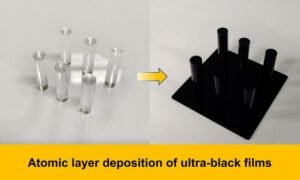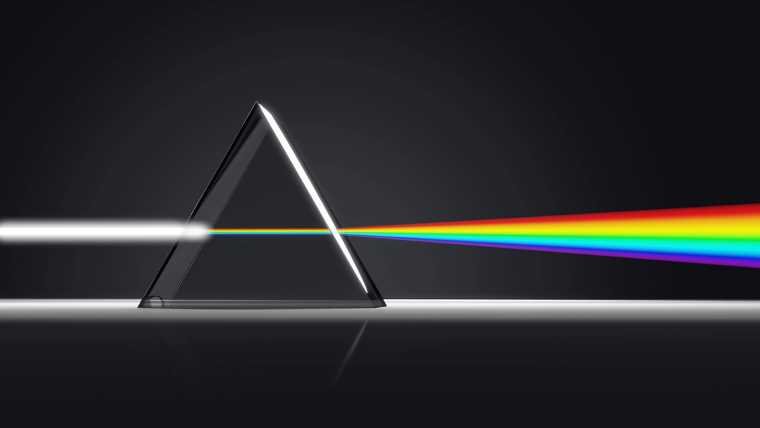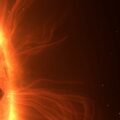A team of engineers says they have created a potentially game-changing “ultrablack” coating that can dramatically improve the efficiency of telescopes and other light-sensitive equipment operating in outer space or other extreme environments.
Applied in a gaseous form, the dual-layer material is versatile enough to cover uniquely shaped equipment yet durable enough to withstand the often harsh environment of space.
Ultrablack Coating Could Improve Performance of Advanced Space Observatories
Space-based observatories like the Hubble Space Telescope and the James Webb Space Telescope are among the most sensitive and complex pieces of scientific equipment ever made. Often more powerful than the best ground-based observatories, their unique attributes lie in their ability to gather extremely small amounts of light from across the cosmos.
Since its launch, Webb has used its array of sensors to measure radiation left over from the Big Bang, captured light from the most distant galaxy ever seen by humans, and is even hoping to spot signs of life in the atmosphere of planets light years away from Earth. However, such meticulous research often involves gathering extremely small amounts of light from objects millions or even billions of light years away.
While the sensors on these types of space observatories are up to the task, their efforts can be stymied by excessive light coming from sources other than their study target. This includes light coming from the satellites themselves, as they reflect at least some of the light they encounter.
Looking to counter the issue of unwanted light, engineers cover these telescopes and their equipment with materials that reflect very little light. Unfortunately, these coverings face many challenges, including versatility and durability.
Now, a team of researchers says they have created a unique, ultrablack material that absorbs over 99% of the light it encounters while also offering enough durability and versatility to be used in even the most complex applications.
Covering Telescopes in Ultrablack Coating is a Real Gas
According to study author Yunzhen Cao, materials that are currently used to cover aerospace-grade materials, such as magnesium alloys, like those used in space telescopes, present engineers with a wide range of challenges. The most common methods, which include things like carbon nanotubes, are extremely fragile, limiting their effectiveness in the harshness of outer space. Things like black silicon are also good at absorbing light, but like nanotubes, they are difficult to apply to anything other than the simplest shapes and structures.


“Existing black coatings like vertically aligned carbon nanotubes or black silicon are limited by fragility,” Cao explained. “It is also difficult for many other coating methods to apply coatings inside a tube or on other complicated structures. This is important for their application in optical devices as they often have significant curvature or intricate shapes.”
Hoping to offer a material that overcomes these limitations while also besting their light reflectivity, researchers from the University of Shanghai for Science and Technology and the Chinese Academy of Sciences say they looked into the concept of applying their ultrablack material in a gaseous form. Known as atomic layer deposition (ALD), this process, which involves exposing the components to sequential layers of gas inside a vacuum chamber, is ideal for covering equipment and components of all shapes and sizes, including inside tubes and crevices that have proven challenging for traditional application methods.
“One big advantage of the ALD method lies in its excellent step-coverage ability,” said Cao, “which means we can obtain uniform film coverage on very complex surfaces, such as cylinders, pillars, and trenches.”
To create an ultrablack coating that reflects as little light as possible, the researchers focused on alternating layers of aluminum-doped titanium carbide (TiAlC) and silicon nitride (SiO2). While neither is as non-reflective as the best materials currently in use, together, they can absorb as much as 99.3% of all light that hits them.
“TiAlC acted as an absorbing layer, and SiO2 was employed to create an anti-reflection structure,” Cao explained. “As a result, nearly all of the incident light is trapped in the multilayer film, achieving efficient light absorption.”
The researchers were also able to apply their dual-layer ultrablack coating to magnesium alloys, which are often used in space components but are known to corrode easily, by adding a third “barrier” layer to the ALD process.
Perhaps just as important, the researchers say their new ultrablack coating is extremely durable. Under testing conditions, it proved well-equipped to handle the wide range of harsh environmental stresses put on equipment operating in deep space.
“What’s more, the film shows superb stability in adverse environments and is tough enough to withstand friction, heat, damp conditions, and extreme temperature changes,” said Cao.
Expanding Material’s Light Absorption into the Ultraviolet and Infrared
The team’s results, published in the journal Vacuum Science & Technology A from the Applied Institute of Physics, show that their process can prevent nearly all light reflected in the visible range. This includes violet light wavelengths as short as 400 nanometers and ranging all the way up to the near-infrared wavelength of 1,000 nanometers.
The engineers behind the new ultrablack coating say they hope to expand their material’s light absorption in the future. Such an advancement would be critical, they note, as some of the most sensitive tools in space observatories like Webb operate outside of the visible light spectrum.
“Now that the film can absorb over 99.3% of incoming visible light, we’re hoping to expand its light absorption range even further to include ultraviolet and infrared regions,” said Cao.
Christopher Plain is a Science Fiction and Fantasy novelist and Head Science Writer at The Debrief. Follow and connect with him on X, learn about his books at plainfiction.com, or email him directly at christopher@thedebrief.org.

